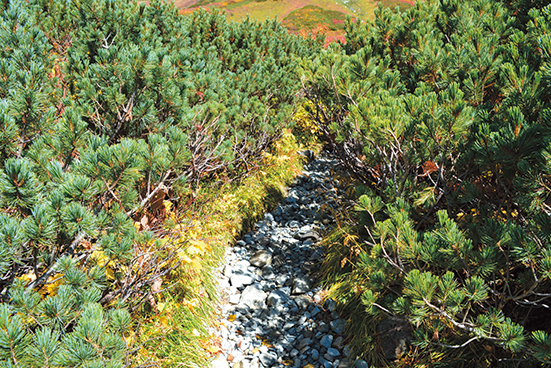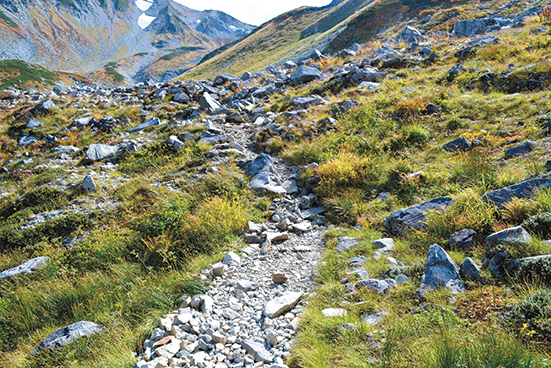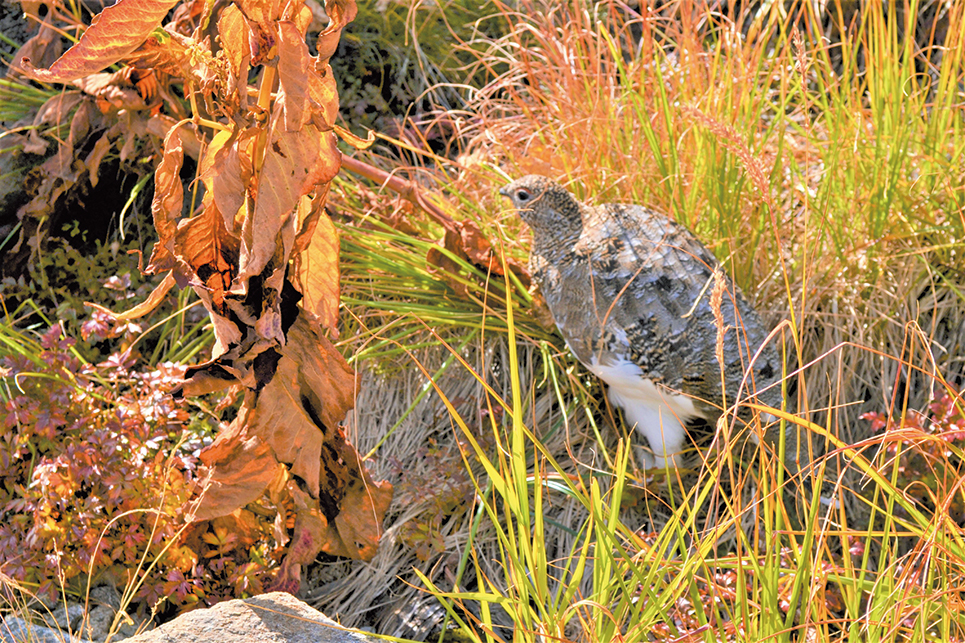【CONTENTS】Looking for Rock Ptarmigan

Almost all of the areas where rock ptarmigan live are whthin a special protection area of the national park. Please do not stray from the estabished mountain path.
Unfortunately, we have to rely mostly on luck, but if at all possible, a sighting is ideal. When searching for the rock ptarmigan please be aware of the items below. They will serve as hints for finding one.
①Cry
The rock ptarmigan male often cries out when staking a claim on territory (mainly in May – June). It gives out various cries, but it has a characteristic cry that sounds almost like a frog when it cries out “Ge, gagga!” A female with a chick (July – September) will also cry out often as she communicates with her young. Unlike the male’s shrill cry, the female’s cry is a gentler “coo coo.”
A newborn chick will also cry out endlessly with a “peep peep” just like a chicken chick, but it cries less as it grows. Pay close attention to what you hear while climbing the mountain, and if you hear its cry, make sure to look around for it.
②Tracks in the field
Rock ptarmigan leave behind various signs of their habitats. A particularly obvious one is their droppings. Unlike most bird droppings, the rock ptarmigan’s droppings resemble long, thin rabbit droppings. Older droppings are brown and dry, but if they are slightly green, that means they are relatively fresh. They also leave a more liquid dropping that resembles an appendix. Rock ptarmigan often bathe in the sand. Finding fresh droppings and traces of a sand bath are evidence a rock ptarmigan was recently in that location.
③The rock ptarmigan’s relationship with weather
Males fighting over territory (May – early June) and females with chicks (July – September, especially early July – mid-August) are easy to find on clear, sunny days.
It is thought that rock ptarmigan only come out when the weather is bad, but that is not the case.For example, from May until early-June, when the territorial battles are more intense, rock ptarmigan can often be seen on clear days watching over their territories from atop rocks in prominent locations. In this season, fights among males break out often when a male is attempting to scare off another male who has invaded his territory. Flying rock ptarmigan are also relatively easy to observe.
Clear days are also better suited for observing females with young chicks. Small, newborn chicks cannot yet cope with bad weather because when the weather is bad, they become so cold it is almost impossible for them to move. On rainy, foggy, or low visibility days, it is easy to spot mature rock ptarmigan, especially males and females who failed to breed (May – November). Rock ptarmigan are wary of birds of prey attacking from above, and therefore take advantage of days with poor visibility. From July through September in particular, it is easy to spot males and females that failed to breed on bad weather days.
④The best time of day to spot a rock ptarmigan
Rock ptarmigan are most active early in the morning and in the evening. The easiest times to spot a rock ptarmigan are 2–3 hours after the sun has risen in the morning and 2–3 hours prior to sunset in the evening.
If you have ever climbed the mountain early in the morning to see the sun rise from the summit, you may have heard the cries of the rock ptarmigan before sunrise. On the other hand, most rock ptarmigan rest during the midday hours making it difficult to find them. In recent years in particular, on clear summer days, despite their preference for warm days, it is too hot for chicks, making it difficult to spot them during the day.


